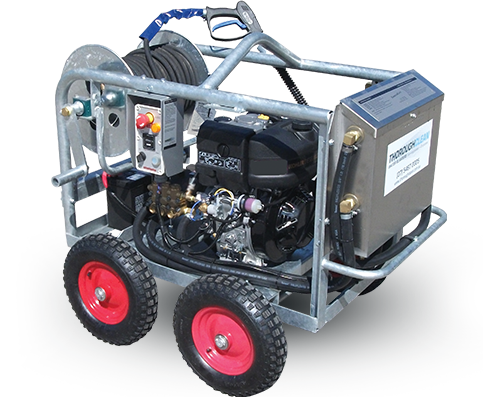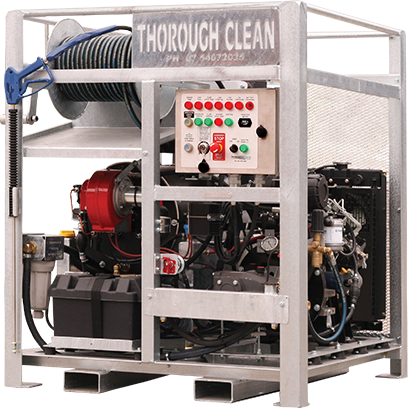What constitutes ‘cleaning power’ in pressure cleaners?
When it comes to cleaning using pressure cleaners, most manufacturers worldwide have always pushed pressure as the sole criteria for choosing a pressure cleaner – which it is not! There are plenty of factors that influence high pressure cleaning.
And what is worse, they would most often state the pump’s maximum pressure rating in all advertising while the horsepower available to drive that pump to this maximum pressure was far less than what is required to actually reach that pressure. Nowhere do they state the actual OPERATING PRESSURE.
So in essence, a pump might be rated to 2,200 PSI, while the effective working pressure is only 1,100 PSI. And because very often domestic and semi-industrial machines are not fitted with pressure gauges, there is no way of telling what the actual operating pressure is.
Some even go as far as stating only the ‘EWP’ (effective working pressure using a Turbo Nozzle) – a practice we too were forced to employ in order to look like we’re stacking up but the difference is that we also stated the maximum pump pressure AND the de-rated pressure – which is really the pressure the machine is set to run at, at a comfortable pace – the real working/operating pressure.
Do you need a pressure gauge fitted ?
So how do you tell what pressure a machine is actually working at? The only way is with a quality pressure gauge fitted to your cleaner.
But getting back to Cleaning Power, the pressure developed is only one part of the equation. A high-pressure cleaner’s ability to clean depends upon a combination of pressure (measured in bar or PSI) and flow rate (in litres per minute). Both are equally important.
Besides there two factors of pressure and flow, there are also a number of other smaller factors that in some cases are very important, which we’ll look at later.
The flow rate in litres per minute (or litres/hour) is a very important measure of the cleaning ability. DIY machines commonly have flow rates as low as 6-8 litres/min. Heavy-duty industrial units have flow rates varying from 10 to 40 litres a minute. Know this: At the same pressure, double the flow means double the cleaning power and speed!
Think of it this way. A litre of water weighs one kilogram. When you look at a pressure cleaner, mentally convert the flow rate from litres to kilograms. A machine throwing 18 kilos a minute at a surface is going to clean 3 times as fast and as well as one throwing only 6 kilos a minute.
(Roughly, an increase in flow rate of one litre per minute is equal to 20 bar or almost 290 PSI in cleaning power.)
How to calculate the cleaning effect of a pressure washer ?
Do you want to calculate the cleaning effect of a pressure washer? Simply multiply the pressure in BAR x the flow in LPM and divide by 600. So a domestic pressure cleaner at 1200 PSI or 83 BAR (divide PSI by 14.5 to get BAR) x 6 LPM /600 = 0.83 which is not great. But increasing the flow to 12 LPM, doubles the cleaning power at the same pressure!
Here are some examples below. Note the diesel and petrol engines are running at a comfortable RPM and at a pace that can be sustained and not flat out. So again, even though it may be possible to run a machine at full revs to get say 4,000 PSI, you wouldn’t do it because your engine won’t last. It is important to look at the engine’s power curve and set it where you get optimal power at a ‘comfortable’ revs for that engine. And that is what we do when we design and set pressure cleaners up.
Below you’re looking at true figures which we set our machines to run at – not unrealistic claims.
MACHINESETTINGSCLEANING EFFECT240 Volt ElectricRunning at 1100 PSI, 6 LPM
| MACHINE | SETTINGS | CLEANING EFFECT |
| 240 Volt Electric | Running at 1100 PSI, 6 LPM (DIY example) |
0.76 |
| 240 Volt Electric | Running at 1100 PSI, 11 LPM |
1.4 |
| 415 Volt Electric | Running at 3500 PSI, 18 LPM |
7.2 |
| 10 HP Diesel driven | Running at 2600 PSI, 18 LPM |
5.4 |
| 24 HP Diesel Driven | Running at 4000 PSI, 18 LPM |
8.2 |
| 5.5 HP Petrol Driven | Running at 1600 PSI, 14 LPM |
2.6 |
| 13 HP Petrol Driven | Running at 2600 PSI, 18 LPM |
5.4 |
| 20 HP Petrol Driven | Running at 4000 PSI, 18 LPM |
8.2 |
A list of all the factors that influence pressure cleaning are:
PRESSURE
(stated in PSI or BAR)
FLOW
Stated in litres per minute (LPM) – double the flow, double the cleaning power!
TIME FACTOR
To clean stubborn mould on cement with a cleaning effect of 0.76. It will take twice as long as with a machine with a 1.5 cleaning effect. A more powerful pressure washer doesn’t necessarily do a better job, it will do the same job in less time.
TEMPERATURE
This is the most over-used technique used to try and increase the cleaning effect. It is expensive and maintenance on boilers is often increased. The correct and often better technique of cleaning stubborn grease is to first blast off as much as you can using high pressure cold water which cuts away the heavy build-up, then apply detergent neat with a low pressure spray pack or bucket & broom.
Leave for the prescribed time to dissolve the grease and oils, then rinse with high pressure cold water again. In saying that, at 80-90 degrees Celsius (the temperature where most hot water high pressure cleaner boilers are set to) most oils will be melted and can be blasted off with ease.
DETERGENTS
Detergents can be injected through the high pressure hose and applied to the surface. This is done at low pressure, which activates the Venturi effect. Sucking in detergent at the pump and diluting it by approximately 90%.
The downsides to this are: Detergent is hugely diluted, losing much of its efficacy, you need special double lance or detergent lances to apply it, injector pick-ups clog up readily if not cleaned daily before use and they can stick shut if not used regularly. The simple answer to this is described under TEMPERATURE above: apply detergent neat using a low pressure spray pack or broom.
OPERATOR TECHNIQUE
This is important. Depending on the type of surface to be cleaned, the operator should vary the pass rate and distance from the surface to allow for different surfaces. The pressure at the nozzle may be 3000 PSI, which at 4” away from a painted surface works beautifully with a fan jet/nozzle, but if you put the tip of the lance right up to the surface, it will most likely damage paint. Always test on an area where you won’t see damage and start from a bit further away, test, then adjust.
PERFORMAVE ENHANCING ACCESSORIES
The use of Turbo Heads (or Roto Jets as some call them) can hugely increase cleaning power, but can damage vulnerable surfaces. They give up to 60% better cleaning effect at the same distance from the surface, which is a massive increase. But can damage timber and other painted surfaces if not careful.
How do they work? Where a fan jet fans out the jet stream as it leaves the lance and at 4” away, a lot of the water impact is spread over a much larger surface. Think of it again as hail stones spread over a large area instead of all concentrated in one spot.
A turbo head keeps the water jet in a pencil jet (not fanned out) so all that explosive power hits the surface in one tiny spot cleaning much better and faster. But it also spins that jet in a cone shape at high speed, so you still get the same area covered for cleaning.
It works very effectively and just about all professional contractors use this for cleaning hard surfaces. Just beware that they are prone to damage fragile surfaces.
LOCAL AMBIENT FACTORS
Other factors that can affect cleaning are water quality (hard vs. soft water). Ambient temperature (warmer water cleans better than icy cold water and the demand for hot water declines in warmer climates as ambient temperature and the water temperature in water lines is increased).
In Summary: Both Operating Pressure and Flow are equally important factors in High Pressure cleaning. Once you’ve got that covered, consider the other factors which were in no particular order. Although Turbo Nozzles and Rotary Surface Cleaners are both tools that will make the job a lot easier!









